
The 6 proven steps to master full life cycle recruiting

Full life cycle recruiting gives you the ability to make strategic hiring decisions. How can you use it to improve your results? In this article, we’re answering questions like “what is full life cycle recruiting” and “What it’s in it for me?”.
Let’s go!
What is full life cycle recruiting?
Full life cycle recruiting refers to the entire hiring process for a new employee. The idea of full life cycle recruiting involves every step of the recruitment phase from start to finish. It is sometimes known as ‘end to end recruiting’ or ‘360 recruitment’.
Stages of full-cycle recruiting
The process can be broken down into six main stages, which can vary according to industry and need. The most common are:
- Preparing
- Sourcing
- Screening
- Selecting
- Hiring
- Onboarding
Full life cycle recruiting begins when there is a need for a new employee and ends when the chosen employee enters the onboarding phase.
Understanding the kind of HR cycle your team uses can be super beneficial. With this knowledge, you can attract better talent to your organization by capitalizing on opportunities to improve each step of the recruitment life cycle. 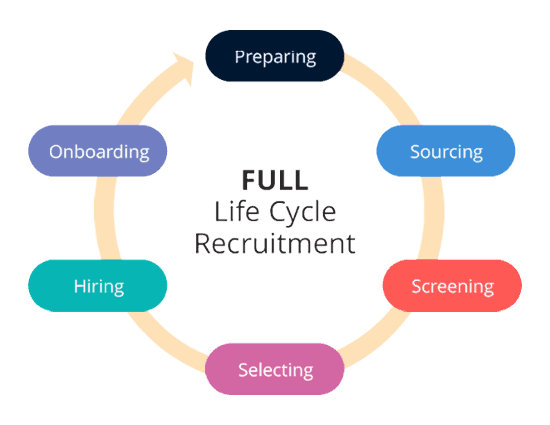
In this article, we’re taking a very close look at full life cycle recruiting and talk you through every step of the process.
Who is in charge of the full life cycle recruiting process?
The person calling the shots for each phase of the cycle is largely dependent on the size of your organization. In a larger business environment, it’s important to delegate these roles early so workplace fluency is not disrupted.
In a smaller setup, the hiring manager, or ‘full-cycle recruiter’ is responsible for every stage of the cycle. As the business grows, so do the number of roles. A middle-sized company often has an HR department of a few people where colleagues share responsibilities.
Companies of a larger size may go a step further and have entire teams working on just one phase of the recruitment life cycle.
Outsourcing the entire process of full life cycle recruiting is becoming an increasingly popular trend for companies of all shapes and sizes.
The steps of a full life cycle recruiting process
A significant body of work goes into the entire cycle of recruiting. There is a minimum of six basic steps, but each can have many layers and tasks associated with them.
#1 Preparation
The preparation stage of the recruitment life cycle is perhaps the most crucial. A lot of the groundwork for the process starts here.
Set your metrics
Before you begin to recruit, you’ll want to determine the recruitment metrics your team will measure so it’s possible to track and evaluate the full life cycle recruiting efforts over time.
There are hundreds of metrics you can measure your results against, here are some we consider to be the most fundamental to success:
- Applicants per Opening
- Application Completion Rate
- Cost of an Unfilled Position
- Time to Hire
- Offer Acceptance Rate
- Cost per Hire
- Quality of Hire
- Employee Retention Rate
Full life cycle recruiting is a major initiative. It’s valuable knowing why your method worked or not. That’s only possible if you track relevant metrics.
Define the candidate persona
Painting a picture of the kind of candidate your company wants to hire should be the next step of the preparation stage.
Simply put, a candidate persona is a fictional representation of your ideal candidate. Often, the persona is created for a specific role that is both detailed and data-driven. This persona is shaped by determining the characteristics, skills, and traits that embody your perfect hire.
In a lot of ways, the candidate persona is the foundation of your full life cycle recruiting efforts. Every decision you make before the hire should be influenced by this research, so it’s worth taking the time to get it right.
Write the job description
Once you’ve defined the ideal candidate persona, you can begin tailoring job descriptions for the prospective candidates. We’ve compiled a list of all the essential elements you should include.
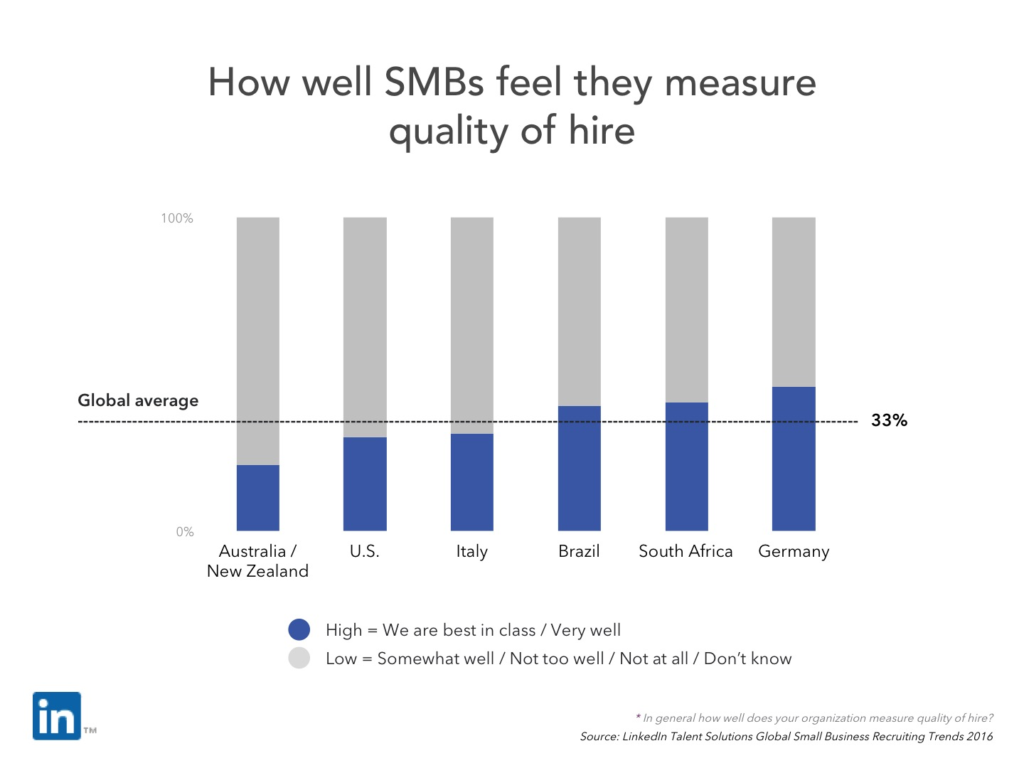 Image credit: LinkedIn Talent Trends Report
Image credit: LinkedIn Talent Trends Report
#2 Sourcing
You now know what your ideal candidate persona is, so it’s time to get started on the sourcing phase of the recruiting life cycle. Investing in some kind of Applicant Tracking System (ATS) or Customer Relationship Management System (CRMS) will help you to organize the candidates in your recruitment pipeline.
Constantly adding to, managing, and analyzing your recruitment pipeline will make it easier to find perfect candidates when a job opening ever arises.
Determine your candidate sourcing strategy
Seventy percent of the global workforce are passive candidates. This means the usual routine of posting on job boards will not garner the best applicants. Have a chat with your hiring manager about what direction you want to concentrate your efforts. Agree upon the different platforms where you can begin your discovery.
Web sourcing
The concept of using a Boolean search can be an effective method to pinpoint candidates of certain backgrounds. You can utilize resume database platforms like Talentbin, Careerbuilder, or Hired. Portfolio websites such as GitHub or Carbonmade can also be useful resources.
Social sourcing
Using social media channels can also be a helpful tool to find out less conventional information about candidates. Start with places like LinkedIn, Twitter, Facebook, and Google+.
Internal and direct sourcing
Be mindful to not overlook any existing employees that could be considered for your open position. The perfect candidate might have been under your nose the entire time.
Believe it or not, recruitment events are as popular as ever, and they’re a great way to get to know candidates outside of their resume and cover letter. A platform like Meetup can facilitate less official, informal meetings like these.
Employee referral programs
A great full life cycle recruiting tip is to look into incentivizing your employees’ recommendations of talent from their networks. Be wary of recruiting exclusively within your networks, as it can lead to excessively homogeneous workplaces.
 Image credit: Blue Signal
Image credit: Blue Signal
#3 Screening
Once you’ve identified qualified candidates in the sourcing phase of the full life cycle recruitment process, it’s time to narrow down that list to what you deem the very best.
Check every resource
Screening begins with reviewing applications that consist of resumes, portfolios, and motivational letters. The aim of reviewing these documents is to find candidates whose skills, qualifications, and experience best match the role that you’re hiring for.
Once you’ve chosen the candidates who impressed you the most on-screen and paper, they’re moved to the next phase of the process – a telephone interview. Candidates who make this cut are shortlisted and invited to a face-to-face interview.
Steps for screening
Here are the steps we consider the most useful for the screening phase:
Step 1: Compile a list of job qualifications based on current successful employees.
Step 2: Categorize each job qualification as a minimum or preferred qualification.
Step 3: Create a resume screening scorecard for the job qualifications to shortlist candidates.
Step 4: Find a good resume screening technology tool, especially if you conduct high-volume recruitment.
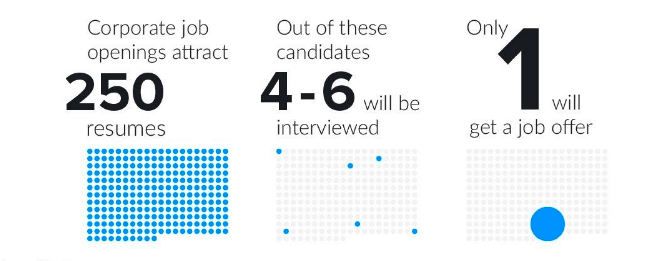 Image credit: Glassdoor
Image credit: Glassdoor
#4 Selecting
You’ve screened your candidates and hopefully, you’ve come out with the cream of the crop. Speaking of selecting, did you know that artificial intelligence can help you do that?
We’re now on to the selecting phase of the full life cycle.
Choose your method
Selecting the best candidate is the most stressful but also rewarding part of the life cycle recruitment process. Despite what the candidate looks like on paper, the interactions you share face-to-face will inevitably be the driving force behind whether you hire them or not.
There are a variety of candidate selection methods available such as competency tests, technical screening, group or panel interviews, and situational exams. DevSkiller’s RealLifeTestingTM Methodology can help you out with the programming side of things.
Structure your interviews
The most tried and trusted method is, of course, by conducting structured interviews. You can drastically increase your chances of making the right hire if you:
- Focus on future planning, not just your immediate needs
- Maintain objectivity and avoid bias
- Provide a superior candidate experience and give feedback
To give you a head start, here is a list of helpful interviewing techniques and questions to kick you off.
Let candidates know when they can expect preliminary information and how they should prepare for the interview. By doing this, you’re able to get the best out of them at a crucial juncture.
It’s important to remember to officially screen the chosen candidate prior to giving them the green light. You can save a lot of hassle by performing a background check and calling the candidates’ references.
Where traditional interviews fail according to recruiters
 Image credit: LinkedIn Global Recruiting Trends Report
Image credit: LinkedIn Global Recruiting Trends Report
#5 Hiring
The light is almost at the end of the tunnel. You’re at the hiring phase of the full life cycle recruitment process. The process comprises two main elements, the job offer, and negotiations. Always call the successful candidate before sending the offer by mail.
Don’t forget about the unsuccessful candidates, you may need them sometime in the future. It’s best to contact them to make them aware of the decision. Remember, talent is four times more likely to consider your company in the future if you offer constructive feedback.
Negotiations
There are times when a candidate will not accept a job offer immediately. Further negotiations are necessary in order to reach a mutually satisfying employment contract for both parties.
This is usually the most sensitive phase of the full life cycle recruiting process. If you anticipate some tight negotiations, get the hiring manager involved right at the start. Negotiations are delicate and you could easily lose your best candidate if you get it all wrong.
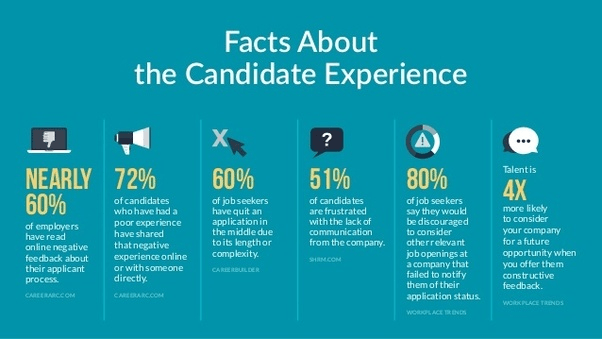 Image credit: Proforma Screening
Image credit: Proforma Screening
#6 Onboarding
Contrary to popular belief, the recruiting process doesn’t end once your candidate accepts the job offer. Ensuring that the candidate has a seamless transition into your organizational culture and environment is critical. Imagine doing all that groundwork and seeing them leave because they were forgotten in their first few weeks of employment.
Development checklist
Create an employee checklist so you can systematically introduce the new employee to their new workplace. High-quality onboarding starts with introductions so ensure they’re familiar with their colleagues and new surroundings.
Your checklist must include everything from preparing mandatory documentation to setting up the workstation and deciding who will meet and greet the new hire upon arrival. Leave no stone unturned to make it a great candidate experience.
A sound onboarding guide
You can follow these steps to ensure your hire has a great experience:
- It’s best not to have a delay between your recruitment process and your onboarding. This period in known as ‘pre-boarding’ and it starts as soon as the candidate’s contract has been signed
- Try to create a special first day
- Brainstorm ideas to make navigating through tedious company documents and systems more tolerable – for instance, use bite-sized nuggets of information
- Constantly check in with your new hires, as often as possible. If there are any issues, you can combat them early and swiftly
 Image credit: TINYpulse
Image credit: TINYpulse
Full life cycle recruiting best practices
For any profession, it pays to stay ahead of the curve. In today’s climate of evolving technology and low unemployment rates, recruitment teams must be at their most innovative to identify and hire the best talent. The following are some best practice tips to help you get the most out of each phase of the cycle:
- Don’t wait for an opening to appear – The most proactive recruiters and sourcers go ahead of their peers and scour the talent pool for candidates eligible for future roles. According to Officevibe, the best candidates are off the market within ten days. Having a range of candidates (active and passive) already in your recruitment pipeline (in the form of an ATS) will be valuable when you do eventually need to fill that opening.
- Have employee needs at the front of mind – What is important to employees might be vastly different to twenty years ago. Consider what factors are attractive to various groups and use them to sell your company to a diverse workforce. We found that eighty percent of candidates would take one job over another based on personal relationships formed during the interview process. They’ll know if you listen.
- Get the most out of tech – Most HR teams are aware of ATS, CRMS (Customer Relationship Management Systems) and HRIS (Human Resource Information Systems), but only fifty-five percent of hiring professionals are utilizing the technology. Implementing a training course for staff could be a useful technique to harness the full potential of this functional software.
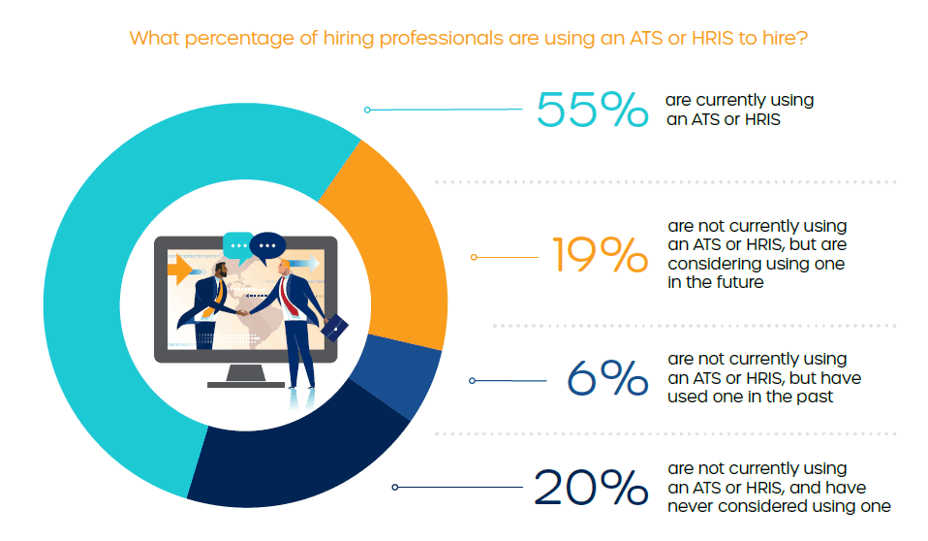 Image credit: Criteria Blog
Image credit: Criteria Blog
Full life cycle recruiting: final thoughts
In full life cycle recruiting, knowing the capacity of your organization goes a long way. If you’re a recruiter in a small or mid-tier firm, time needs to be spent wisely to optimize the process wherever possible.
Following a full life cycle recruiting approach, with the guidance of the above-mentioned pointers, can help decrease your Cost-per-Hire as well as your Time-to-Hire. Overall, your recruitment strategy will be working a whole lot better due to instilling an efficient and structured process.




